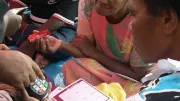Recent Blogs
Blog
The Many Faces of the Poor: Mass Market Segmentation
The AppLab Money Incubator in Uganda has studied and segmented the behaviors of rural low-income consumers to understand the opportunity for financial services product development.Blog
Driving Financial Inclusion Innovation: Why Startups and Why Now?
The recently established Accion Venture Lab aims to play a more active role in identifying and accelerating the next generation of innovative financial inclusion enterprises.Blog
Savings and Credit on Mobile: The Jipange KuSave Experiment
The results of an experiment with a lend-to-save model in Kenya, Jipange KuSave, showed that there is demand for financial services which are quite different from those currently offered by mainstream providers.Blog
Lessons from India on Weather Insurance for Small Farmers
With 22 million farms covered by a yield based index, 3 million by a weather index insurance and 340,000 farms covered by an insurance combining the two indices, India is probably today the most innovative and experienced country in agricultural index insurance in the world.Blog
Early Insights into Rural Adoption of M-Payments in Mexico
CGAP has worked closely with Telecomm Telégrafos in Mexico to find out if people in isolated communities who lack cellular coverage, and are far away from any financial institution are willing to use a mobile account, and if so what kind of transactions are they more likely to carry out. This post provides some insights on how mobile accounts are adopted under these conditions and what is the value proposition in the eyes of the consumer.Blog
Financial Inclusion by Design: AppLab Money Incubator Case Study
Grameen Foundation, MTN and CGAP launched the AppLab Money Incubator a year ago, in part, to develop a human-centered design process that shows players with an appetite to go down-market that innovation can be cost-effective and impactful and can also lead to new areas of growth. This is the first part of a case study documenting our experience.Blog
Beyond the Mzansi Account in South Africa – Targeting Usage
Between 2004 and 2008 the percentage of banked South African adults increased from 46% to 63%. This feat was driven primarily by the six million Mzansi accounts that were opened over that period – two-thirds of which by people that had never before had a bank account. However, approximately 30% of these were inactive. This post explores the importance of understanding the financial needs of low income clients, and how business models need to adapt to meet those needs on an economically viable basis.Blog
Cash Management Innovation in Latin America
An ongoing trend in Latin America is bringing forward an innovative solution to the problem of cash management through a far-reaching network of small retailers who process cash payments in real time. Could this be a way to forge a Latin American alternative path to address the problem of liquidity management?Blog
Applied Research Methodologies for Financial Inclusion
In September 2011, CGAP’s Technology team invited the Brazilian firm Plano CDE to develop a study that would help them understand the behaviour, needs and expectations of low-income Brazilians in relation to financial instruments. The goal of the study was to contribute to the development of a new financial product or service that would attend to the needs of lower-income consumers and enhance their relationship with financial institutions.Blog
The Potential of Electronic Money for Social Good
The efforts of the global development community to harness the power of electronic money for the social good got a big shot in the arm last week. On the sidelines of the 2012 UN General Assembly a coalition of leading countries, global NGO’s, development agencies and the private sector came together and formed the “Better-Than-Cash” Alliance. This coalition can make a real difference.Blog
Delivering Technology Solutions to Susu Collectors
Susu collectors are one of the oldest financial services in Africa. Based largely in Ghana and Nigeria, they visit clients on a regular basis (often daily), collecting very small deposits over the course of a month. This post examines a Ghanaian susu solution which involves a POS device which prints a receipt for the customer and transmits the information back to the susu company’s home office IS system for real-time reconciliation.Blog
What Is the Role of Start-Ups in Financial Inclusion?
This post explores the role of start-ups in financial inclusion by highlighting some of the themes from the recent Finovate event.Blog
The Growth of Mobile Financial Services in Bangladesh
In early 2010, we blogged about the steps identified for mobile financial services to take off in Bangladesh. Bangladesh has moved partly down this path. A newly released overview report on Mobile Financial Services by Bangladesh’s Central Bank highlights the progress achieved two years on.Blog
Are Lower-end Shops Ripe for Electronic Payments?
Are payment dongles like Square democratizing retail electronic payments by eliminating the need for dedicated point-of-sale terminals. Is the growth curve of Square an indication that similar low-cost acquiring solutions could trigger an explosion of merchant payments in developing countries?Blog
Are You Getting Your Share? Revenue Protection in Mobile Money
Mobile money has had bad press lately for fraud-related cases. Most of the reported cases were either the result of internal employees misusing the system to cause operator losses or fraudsters trying to scam unsuspecting users. There is another angle that rarely gets any press—when users or agents abuse the platform and use it in rogue ways that it was never intended.Blog
Banking 100 Million Pakistanis
This post on a recent report on Interoperability provides insights on why interoperability might be important, how we should think about it from a policy and market development perspective and how it should be measured, especially as it relates to financial inclusion.Blog
Mobiles – A Mass-Customizable Financial Tool?
A financial service for the base of the pyramid must, at its core, help people with their financial planning. This notion can help articulate the logic of user interface design. A provider that helps people plan better will be in a better position to promote its own financial products.Blog
Unlocking Barriers: Advances in Rural Mobile Banking in Mexico
Telecomm is a decentralized government agency that operates the telegraph services, bridges data connectivity across the territory, and offers financial services such as domestic and international remittances, as well as bill payments. It has decided to launch a pilot program which seeks to close the three most common gaps in financial inclusion: technological infrastructure, channels and products.Blog
INOVA: Oasis of Innovation in the West African Desert
INOVA is the first e-money issuer authorized by the central bank in Burkina Faso to offer services of its kind. It is the first company to have a top-notch platform for the Inovapay wallet developed and implemented in the developing world, offering services that are multi-channel, multi-operator, multi-currency, multi-lingual, and multi-institutional.Blog



